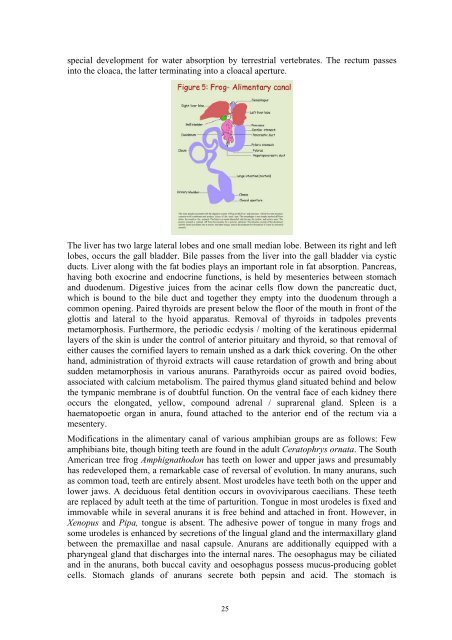Animal Diversity: Chordata
Animal Diversity: Chordata
Animal Diversity: Chordata
You also want an ePaper? Increase the reach of your titles
YUMPU automatically turns print PDFs into web optimized ePapers that Google loves.
special development for water absorption by terrestrial vertebrates. The rectum passes<br />
into the cloaca, the latter terminating into a cloacal aperture.<br />
The liver has two large lateral lobes and one small median lobe. Between its right and left<br />
lobes, occurs the gall bladder. Bile passes from the liver into the gall bladder via cystic<br />
ducts. Liver along with the fat bodies plays an important role in fat absorption. Pancreas,<br />
having both exocrine and endocrine functions, is held by mesenteries between stomach<br />
and duodenum. Digestive juices from the acinar cells flow down the pancreatic duct,<br />
which is bound to the bile duct and together they empty into the duodenum through a<br />
common opening. Paired thyroids are present below the floor of the mouth in front of the<br />
glottis and lateral to the hyoid apparatus. Removal of thyroids in tadpoles prevents<br />
metamorphosis. Furthermore, the periodic ecdysis / molting of the keratinous epidermal<br />
layers of the skin is under the control of anterior pituitary and thyroid, so that removal of<br />
either causes the cornified layers to remain unshed as a dark thick covering. On the other<br />
hand, administration of thyroid extracts will cause retardation of growth and bring about<br />
sudden metamorphosis in various anurans. Parathyroids occur as paired ovoid bodies,<br />
associated with calcium metabolism. The paired thymus gland situated behind and below<br />
the tympanic membrane is of doubtful function. On the ventral face of each kidney there<br />
occurs the elongated, yellow, compound adrenal / suprarenal gland. Spleen is a<br />
haematopoetic organ in anura, found attached to the anterior end of the rectum via a<br />
mesentery.<br />
Modifications in the alimentary canal of various amphibian groups are as follows: Few<br />
amphibians bite, though biting teeth are found in the adult Ceratophrys ornata. The South<br />
American tree frog Amphignathodon has teeth on lower and upper jaws and presumably<br />
has redeveloped them, a remarkable case of reversal of evolution. In many anurans, such<br />
as common toad, teeth are entirely absent. Most urodeles have teeth both on the upper and<br />
lower jaws. A deciduous fetal dentition occurs in ovoviviparous caecilians. These teeth<br />
are replaced by adult teeth at the time of parturition. Tongue in most urodeles is fixed and<br />
immovable while in several anurans it is free behind and attached in front. However, in<br />
Xenopus and Pipa, tongue is absent. The adhesive power of tongue in many frogs and<br />
some urodeles is enhanced by secretions of the lingual gland and the intermaxillary gland<br />
between the premaxillae and nasal capsule. Anurans are additionally equipped with a<br />
pharyngeal gland that discharges into the internal nares. The oesophagus may be ciliated<br />
and in the anurans, both buccal cavity and oesophagus possess mucus-producing goblet<br />
cells. Stomach glands of anurans secrete both pepsin and acid. The stomach is<br />
25

















